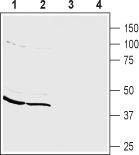Overview
- Peptide (C)RARFSQMRKDVLEK, corresponding to amino acid residues 305-318 of rat PICK1 (Accession Q9EP80). Intracellular, α-helix domain.
- Human PANC-1 pancreatic carcinoma and HepG2 liver carcinoma cell lysates. Rat and mouse brain lysates (1:200-1:1000).
 Western blot analysis of human PANC-1 pancreatic carcinoma cell lysate (lanes 1 and 3) and human HepG2 liver carcinoma cell lysate (lanes 2 and 4):1,2. Anti-PICK1 Antibody (#APZ-014), (1:200).
Western blot analysis of human PANC-1 pancreatic carcinoma cell lysate (lanes 1 and 3) and human HepG2 liver carcinoma cell lysate (lanes 2 and 4):1,2. Anti-PICK1 Antibody (#APZ-014), (1:200).
3,4. Anti-PICK1 Antibody, preincubated with PICK1 Blocking Peptide (#BLP-PZ014). Western blot analysis of mouse (lanes 1 and 3) and rat (lanes 2 and 4) brain membranes:1,2. Anti-PICK1 Antibody (#APZ-014), (1:200).
Western blot analysis of mouse (lanes 1 and 3) and rat (lanes 2 and 4) brain membranes:1,2. Anti-PICK1 Antibody (#APZ-014), (1:200).
3,4. Anti-PICK1 Antibody, preincubated with PICK1 Blocking Peptide (#BLP-PZ014).
- Mouse brain sections (1:400).
PICK1 interacts with the PDZ motifs of several proteins, including: protein kinase C α (PKC α), glutamate receptors (GluRs), prolactin-releasing peptide (PrRP), acid-sensing ion channel (ASICs), dopamine transporter (DAT), Karlirin 7, ephrin type-B receptor 2 (EphB2),ErbB2 / Her-2, TIS21, coxsackie virus and adenovirus receptor (CXADR), and UNC5H.
The proteins interacting with PICK1 have roles in synaptic plasticity, neuronal cell morphology, and mitochondrial-dependent apoptosis. In most of the cases, PICK1 acts as a critical regulator of membrane receptors' subcellular trafficking to modulate neural processes such as learning and memory1.
PICK1 is widely expressed in the brain, testis, heart, lung, liver, kidney and muscle2.
Its abnormal expression in brain has been linked to drug abuse and dependence, schizophrenia, and psychosis. Recent evidence suggest that PICK1 may affect human cancer development3,4. PICK1 has also been reported to be expressed in insulin-producing pancreatic beta-cells where it may play a role in the neuroendocrine system5.
